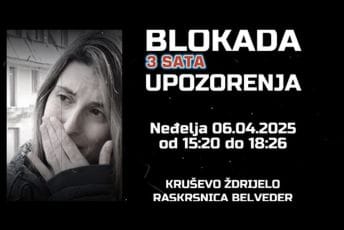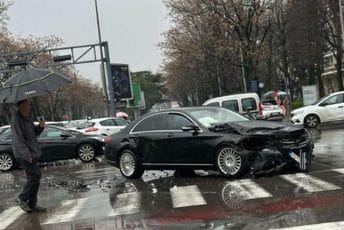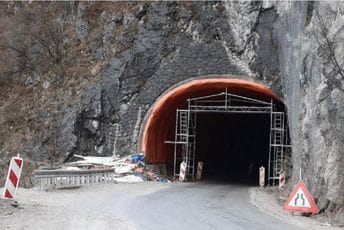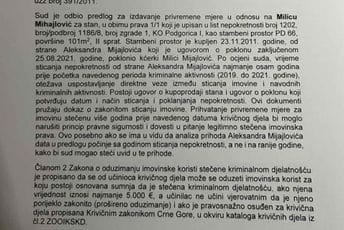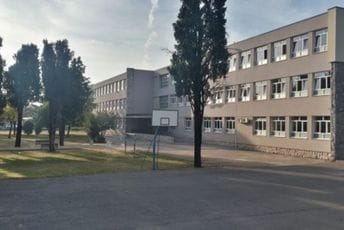Osim oružanih snaga i druge američke jedinice, naročito Crveni krst, takođe su bile prisutne u Crnoj Gori prvih poslijeratnih godina. Crveni krst je svoje sudjelovanje u Crnoj Gori zapravo počeo još 1915. godine, kada je agent sanitarne komisije u Srbiji, Albaniji i Crnoj Gori uspio povećati pomoć za vrijeme epidemije tifusa u regiji.
Pomoć jedinice američkog Crvenog krsta počela je dolaziti u Crnu Goru u zimu krajem 1918. i početkom 1919. godine.
Američki Crveni krst je ostao u Crnoj Gori više od četiri godine. Posljednja jedinica je povučena početkom ljeta 1922.
Portal Analitika objavljuje originalna svjedočenja na engleskom jeziku iz arhiva Američkog crvenog krsta sa zabilješkama i fotografijama njihovog osoblja. Svjedočenja i fotografije koje su oni zabilježili tokom svoga boravka i nesebičnog rada u Podgorici nakon Velikog rata.
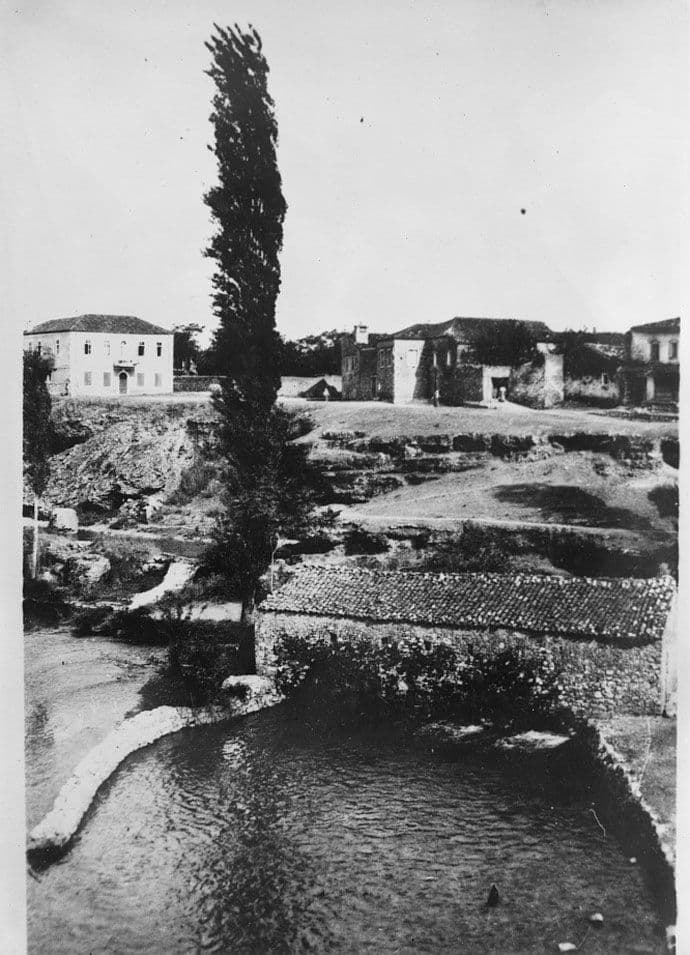
Slika1
The Land of Wasted Waterpower. Sufficient water power to give the Balkans innumerable modern comforts goes to waste daily. With the exception of a few old mills, like the old stone building near the stream in this picture, there has been practically no development of this vast resources. This is a scene along the river at Podgoritza, Montenegro, where there is water power sufficient to give light and power to the entire city. But kerosene is still used. The Balkans countries are a hundred years behind in progress, due principally to their political and geographical position. But today Americans, doing Red Cross relief work among these people, have put new ideas into their heads, and a new spirit of progress is gradually growing among them
Postoji dovoljna snaga vode koja bi na Balkanu obezbijedila bezbroj savremenih komfora ali prolazi uzaludno dnevno. Sa izuzetkom nekoliko starih mlinova, kao i staroj kamenoj zgradi u blizini potoka na ovoj slici, nije bilo praktičnog razvoja ovih ogromnih resursa. Ovo je scena uz rijeku u Podgorici, Crna Gora, gdje je vodena snaga dovoljna da daje svetlo i električnu energiju u cijelom gradu. Ali kerozin se i dalje koristi.

Slika2
Tallest Tree in Montenegro. Scene near American Red Cross headquarters at Podgoritza, Montenegro. The tree in the center is named after ex-King Nicholas, and is said to be the tallest tree in the country
Najviše Drvo u Crnoj Gori. Scena u blizini štaba američkog Crvenog krsta u Podgorici, Crna Gora.
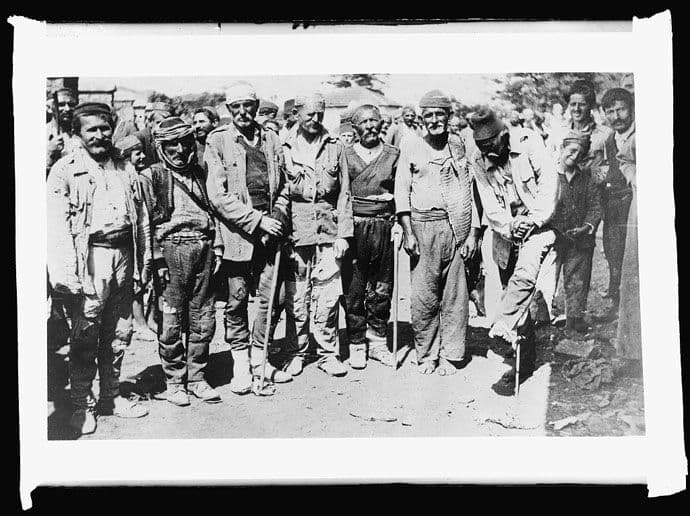
Slika3
Back in '61. These Montenegrin veterans were fighting and they are still at it more or less of the time today. During the past five years they fought a common enemy, the Austrians. Now that the Austrians have been driven out, they have picked up their old internal troubles where they were dropped in 1914. As a result of this lack of cohesive government Montenegro today is one of the most destitute countries in Europe despite the fact that its people are the most hardworking, patient and honest. This picture is an illustration of their condition. These men came as far as forty miles to the American Red Cross clothing distribution in Podgoritza on the day this picture was taken
Povratak u '61. Ovi crnogorski veterani su se borili i još uvek su u toj borbi više ili manje vremena i danas. Tokom proteklih pet godina, oni su se borili protiv zajedničkog neprijatelja, Austrijanaca. Sada, kada su Austrijanci protjerani, oni su pokupili svoje stare unutrašnje probleme gdje su stali u 1914. Kao rezultat ovog nedostatka kohezivne vlade Crna Gora danas je jedna od najugroženijih zemalja u Evropi, uprkos činjenici da su njeni ljudi najviše vrijedni, strpljivi i pošteni. Ova slika je ilustracija njihovog stanja. Ovi ljudi su došli sa preko četrdeset milja na distribuciju odjeće u američki Crveni krst u Podgorici.
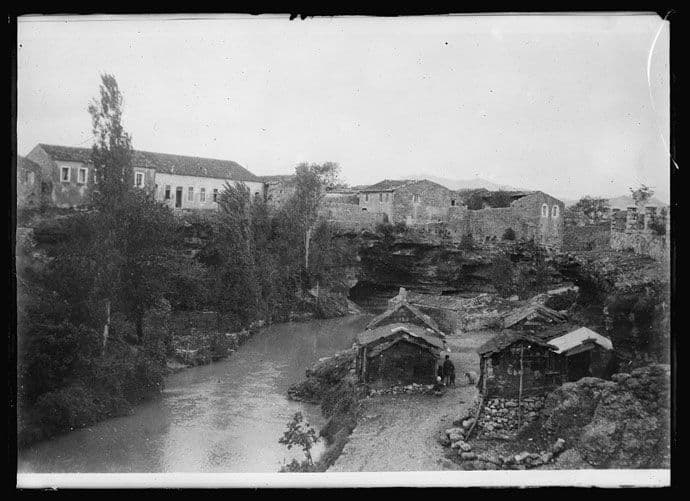
Slika4
Houses of Gasoline Tins. Since the invasion of the enemy during which many houses in Montenegro were destroyed, any material that can be turned in to a shelter is used. This shows what several enterprising families did with gasoline tins that they salvaged from the American Red Cross garage, which furnishes transportation for the distribution of relief supplies in the district around Podgoritza. The cans were flattened out and pieced together with solder, wire, nails, and any other available means. These shacks are the result. Part of the devastation wrought in Podgoritza by the war can be seen in the roofless and town houses in the background
Kuće od bensinskih konzervi. Od invazije neprijatelja tokom koje su uništene mnoge kuće u Crnoj Gori, koristi se bilo koji materijal kojim se može napraviti sklonište. Ova fotografija pokazuje što je više preduzimljivih porodica uradila sa benzinskim konzervama koje su dobili iz garaže Američkog Crvenog krsta , koja vrši smještaj i prevoz kao i distribuciju pomoći zaliha u dijelu oko Podgorice.
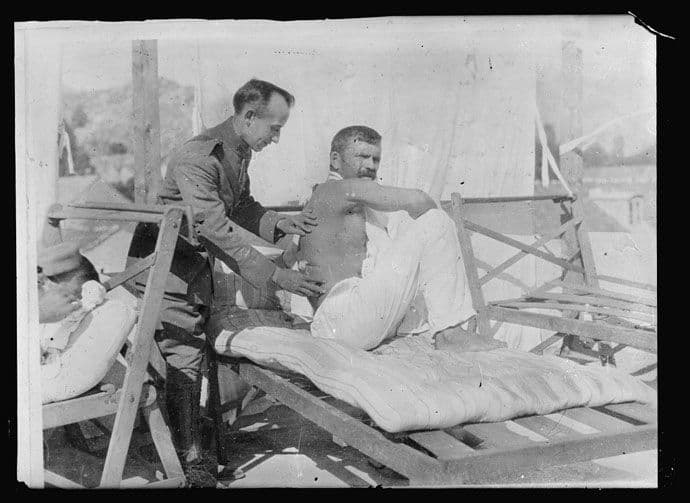
Slika5
The Miracle Man. Dr. Joseph F. Jaros of Chicago, dressing the wounds of a Montenegrin at the American Red Cross hospital at Nicsic. This young American physician, who has a war record in France and Belgium, has performed miracles in the eyes of the poor Montenegrins in saving hundreds of people afflicted with wounds and disease. The patient in this picture was stabbed in a feud and spent a week trying to cure himself with a rabbit skin and cobwebs. Finally he stumbled into the Red Cross hospital almost dead
Čudo Čovjek. Dr Džozef F Jaros of Chicago, previja rane Crnogorcu u bolnici američkog Crvenog krsta u Nikšiču. Ovaj mladi američki ljekar, koji je ratni veteran u Francuskoj i Belgiji, je činio čuda u očima siromašnih Crnogoraca u spašavanju stotina ljudi koji pate od rana i bolesti. Pacijent na ovoj slici je izboden u zavadi i proveo nedelju dana pokušavajući da se izliječi. Na kraju je dospio u bolnicu Crvenog krsta skoro mrtav.
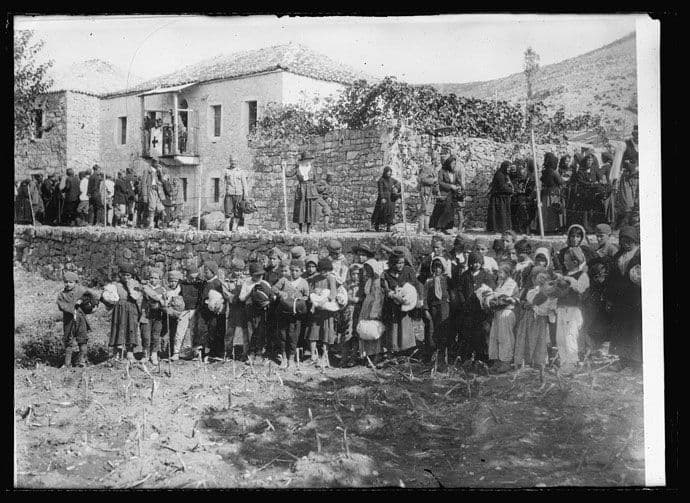
Slika6
A Red Letter Day at Smokovatz. A group of Montenegrin children before the American Red Cross relief station at Smokovatz, where they have just received a bundle each of cast-off American garments. Fifteen hundred destitute mountain people got clothing on this day. In the background can be seen some of them still in line before the Red Cross station. It is the first clothing of any sort they have seen in five years. The old clothing is doing yeoman service, in the cold mountain regions this winter
Dan Crvenog Pisma u Smokovcu. Grupa crnogorske djece ispred stanice američkog Crvenog krst u Smokovcu, gdje su upravo dobili gomilu stvari sa američkom odjećom. To je prva odjeća bilo koje vrste koje su vidjeli u pet godina. Stara odeća čini stvarnu uslugu, u hladnim planinskim područjima ove zime.
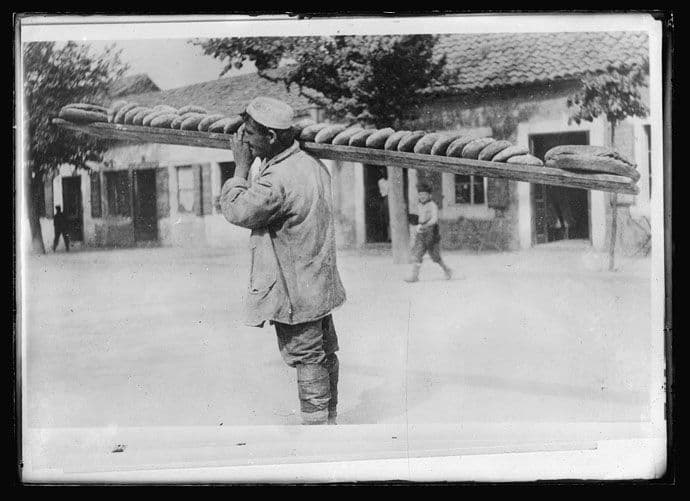
Slika7
f the Bakers' Union Knew. What goes on in Montenegro among the followers of their craft, there would be a great to-do. For after a baker gets done baking, he goes out himself and peddles the bread. Like the picture, the bread is carried on a long board, containing thirty three loaves weighing five pounds each some load. But while the housewives can't complain of the service, the American doctors and nurses who are fighting the American doctors and nurses who are fighting disease in the Balkan country don't like the method. It is unsanitary and many cases of disease have been traced to it, according to the Americans. This custom and many others connected with the food supply, the Americans are trying to correct in aiding Montenegro to get on its feet again
Unija pekara zna. Ono što se dešava u Crnoj Gori među pristalicama ovog zanata, mogao bi biti sjajan posao. Nakon što pekar završi pečenje hljeba, on izlazi i raznosi hljeb. Kao na slici, hljeb se nosi na dugoj dasci, koja sadrži trideset tri vekne težine pet kilograma svaka. Ali, dok domaćice ne mogu da se žale na usluge, američki ljekari i medicinske sestre koji se bore protiv raznih bolesti u toj balkanskoj zemlji ne vole taj metod. To je nehigijenski i mnogi slučajevi bolesti su njeni pratioci , prema Amerikancima. Ovaj običaj i mnogi drugi vezani za snabdijevanje hranom, Amerikanci pokušavaju da isprave u pomaganju Crnoj Gori da ponovo stane na svoje noge.
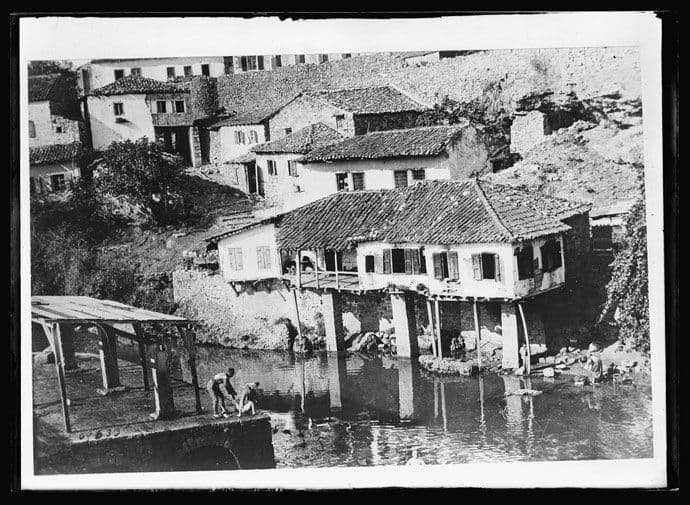
slika8
Something New in Taxing Line. A scene at Podgoritza, Montenegro, showing the housing conditions. Note that there is not a chimney in sight. As there was a tax on chimney in the country under the old regime, the people preferred to let the smoke from their fires find an outlet through the windows. This led to a prevalence of eye and other diseases. American Red Cross doctors doing relief work in Montenegro say that the chimney tax scheme led to conditions that have made 60 percent of the civilian population tubercular. To combat this the Red Cross has inaugurated an educational campaign on sanitary living conditions
Nešto novo u oporezivanju. Scena u Podgorici, Crna Gora, pokazuje uslove stanovanja. Imajte na umu da ne postoji dimnjak na vidiku. S obzirom da je plaćan porez na dimnjak u zemlji pod starim režimom, ljudi su radije provodili dim iz njihovih peći da nađe izlaz kroz prozore. To je dovelo do rasprostranjenosti bolesti oka i drugih bolesti. Ljekari američkog Crvenog krsta koji rade humanitarni rad u Crnoj Gori kažu da je oporezovanje dimnjaka dovelo do stanja koje su napravile 60 odsto civilnog stanovništva na granici bolesti od tuberkuloze. Da bi se suprostavio ovoj pojavi Crveni krst je otvorio edukativnu kampanju o sanitarnim uslovima života
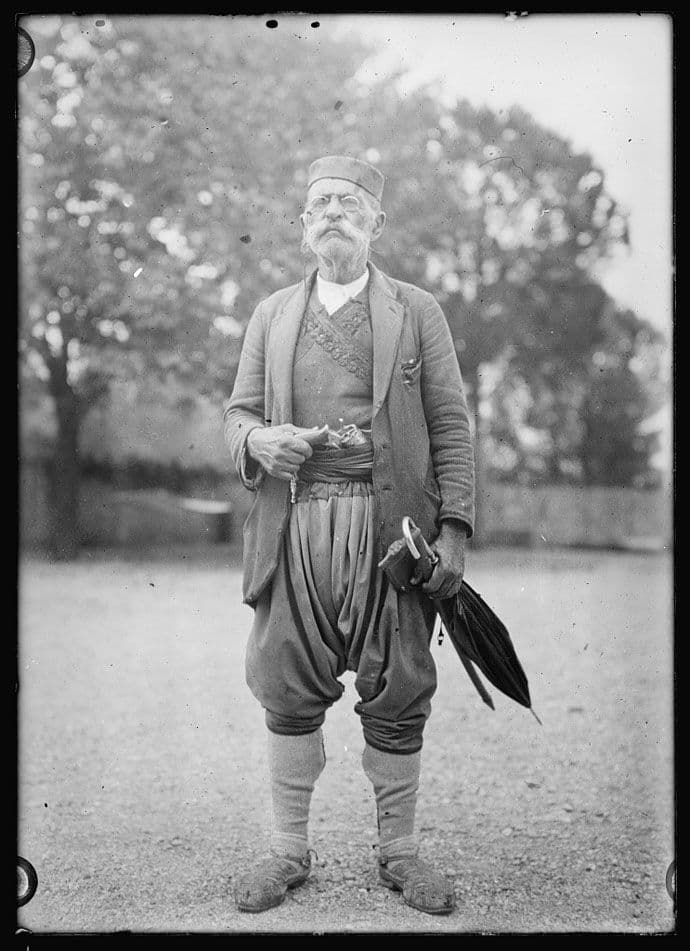
Slika9
"Tiger Tiger" A fine type of the old Montenegrin whose bravery and strong national spirit is a by word in Eastern Europe. They are known as the tigers of the Balkans, because of the fact that they still have a country despite conquests by half a dozen stronger nations. He is dressed in his Sunday best for a visit to his son who is a patient at the American Red Cross hospital is Podgoritza. Men of his stamp are not dependent upon the law to portect them, as the revolver and bayonet indicate
"Tigar" Tipični predstavnik starog Crnogorca čija hrabrost i jak nacionalni duh je poznat u istočnoj Evropi. Oni su poznati kao tigrovi na Balkanu, zbog činjenice da oni još uvijek imaju svoju zemlju, uprkos pokušajima osvajanja od pola tuceta jačih zemalja. On je obučen u svom najboljem odijelu za posjetu svom sinu koji je pacijent u bolnici američkog Crvenog krsta u Podgorici.
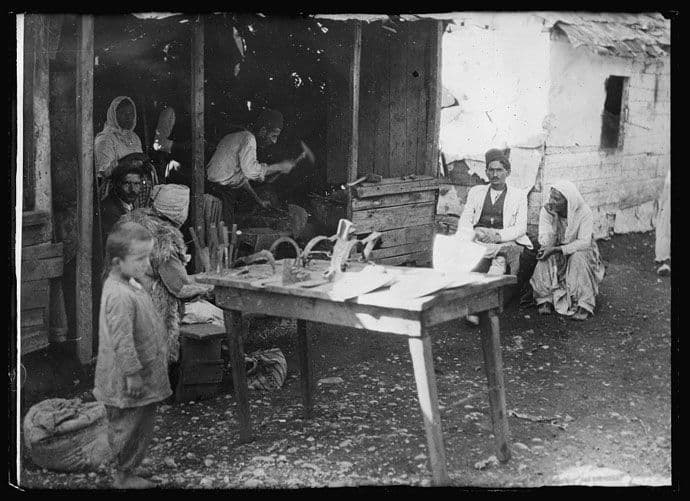
Slika10
Village Smithy Has Many Trades. A typical village blacksmith's shop in Podgoritza, Montenegro. The smithy in the Balkans is a jack of all trades. He pulls teeth, grinds the family knives, mends watches, repairs ploughshares and shoes, oxen, donkeys and horses. The people seated about his shop are peasants who are waiting for repairs to their farm implements. They are possessed of but one ploughshare or hoe and when it breaks they must hold up their work until it is repaired. This condition illustrates the reason why Balkan war reconstruction is slow. There are few tools to work with. The only aid received so far has been from America, the Red Cross bringing in a million dollars worth of modern farm machinery to sow and harvest the crops, meanwhile giving out clothing, food, and medicine in order that the people might live
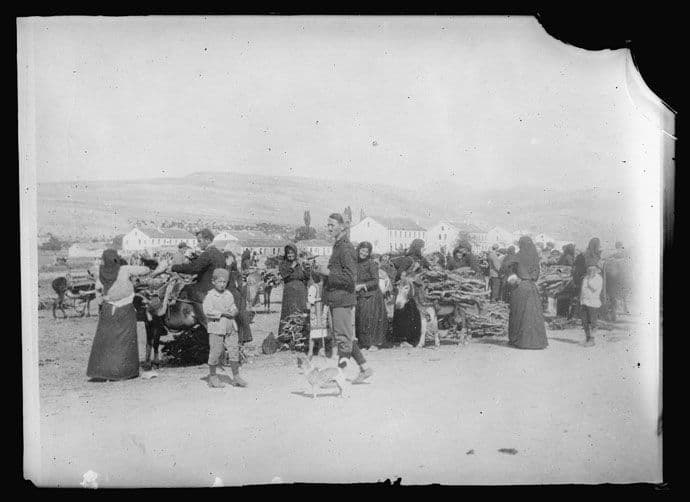
Slika11
Fuel enough for thousands. Those who feel very badly about the fuel shortage in America might obtain a grain of comfort from this picture. This is the wood market at Podgoritza where people bring a few pounds of wood from many miles distance. Few houses are heated in Montenegro especially since the war, as the invading enemy stripped the country of what little timber it had. American Red Cross doctors have been kept on the jump this winter in an effort to stem the tide of pneumonia and other winter diseases that are attacking these destitute people as a result of their weakened vitality brought on by five years of suffering. Fuel is a luxury in this little Balkan state
Gorivo dovoljno za hiljade. Oni koji se osećaju veoma loše zbog nestašice goriva u Americi mogu dobiti zrno udobnosti sa ove slike. Ovo je tržište drva u Podgorici gdje ljudi donose drvo sa velike udaljenosti. Nekoliko kuća se greje u Crnoj Gori, posebno poslije rata, pošto im je okupator neprijatelj bio oduzeo i ono malo drveta koje su imali. Gorivo je luksuz u ovoj maloj balkanskoj državi.
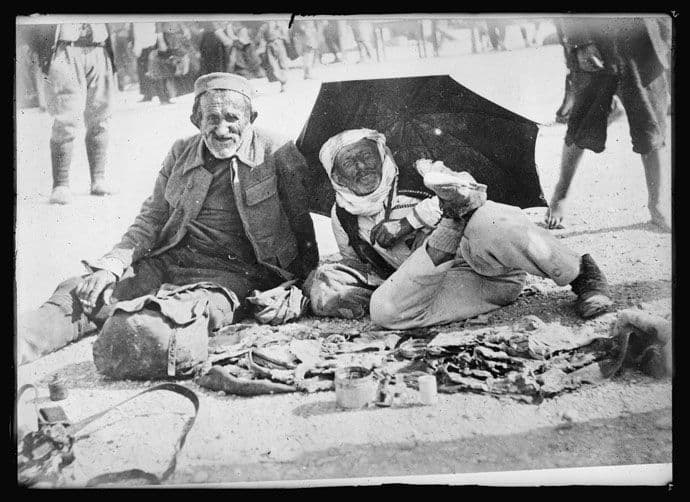
Slika12
One Day's Work a Week. That is all that many men in Montenegro can find. These two old men, each of them having passed the four-score mark, amply illustrate that condition. They are harness makers waiting in the market at Podgoritza for business. But as there are no horses left, the enemy having driven them all off the harness trade does not flourish. They work at their trade but one day a week. On the other five they are employed by the American Red Cross along with many other needy persons, to clean the streets, improved sanitary conditions and aid about the American relief station. In this way they manage to earn a comfortable living and at the same time help their less fortunate brethren
Jedan radni dan u nedjelji. To je sve što mnogi ljudi u Crnoj Gori mogu naći. Ova dva starca, dovoljno ilustruju taj uslov. Oni čekaju na tržnici u Podgorici za posao. Oni rade na svojim poslovima, ali samo jedan dan nedjeljno. Drugih pet dana su zaposleni od strane američkog Crvenog krsta zajedno sa mnogim drugim ugroženim licima, da čiste ulice, poboljšaju sanitarne uslove i pružaju neophodnu pomoć u stanici američkog Crvenog krsta. Na ovaj način su uspeli da zarade za udoban život i istovremeno pomognu manje srećnu braću.
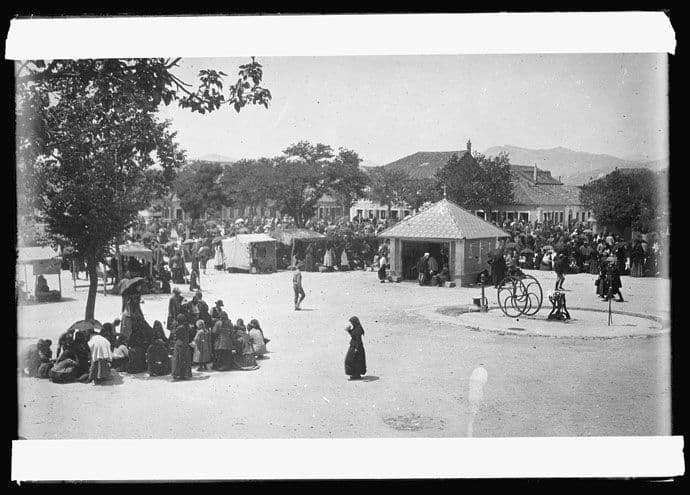
Slika13
Mentenegrin Markets Barren of Food. Podgeritza's market place and the familiar town pump in the center of the square. There is little to be brought these days at the markets of Montenegro for little is produced in this devastated country where the best man-power has been lost through the war and where the heavy labor has been left entirely left to women, already overburdened and weakened with hunger. But for the intervention of the American Red Cross and the timely support of the Juniors of America in furnishing supplies of food, clothing and medicines Montenegro would doubtless be today a land of the dead
Crnogorskim pijacama nedostaje hrane. Na slici se vidi Podgorička pijaca i gradska pumpa na centru trga. Malo što može da se kupi ovih dana na tržištu Crne Gore, vrlo malo se proizvodi u ovoj razorenoj zemlji u kojoj je najbolja ljudska snaga izgubljena tokom rata i gdje je težak rad ostao u potpunosti prepušten ženama, koje su već preopterećene i oslabljene od gladi.
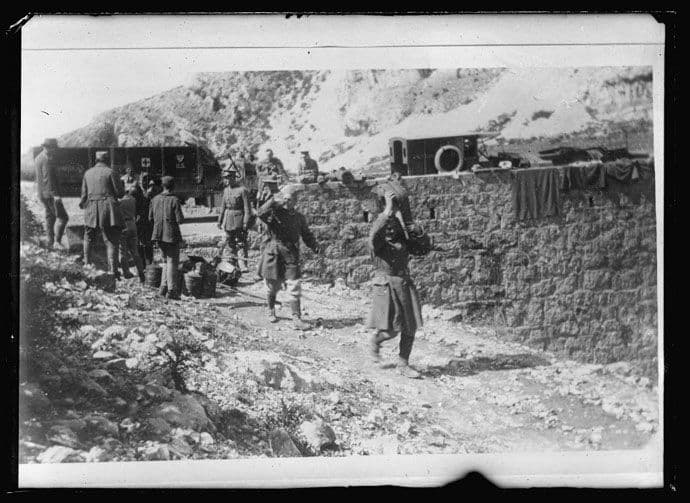
Slika14
Crossing An Impassable Mountain. Illustrating one of the little transport irritation of life met by American Red Cross workers in Montenegro. In order to get sorely needed relief supplies to a certain section of this country, the Red Cross had to get its trucks beyond an impassable mountain. The trucks were driven to the last negotiable point and then taken apart and carried on the backs of eighty porters to the other side and assembled again. The work was accomplished in two days and the relief arrived on time. This picture shows the trucks being "knocked down" and porters starting across with the parts.
Prelazak preko neprohodne planine. Fotografija ilustruje jedan od ne malog broja transportnih problema koji je dočekao američki Crveni krst u Crnoj Gori. Da bi dostavili krajnje potrebne zalihe humanitarne pomoći u određenom dijelu ove zemlje, Crveni krst je morao da prenese svoje kamione preko neprohodne planine. Kamioni su dovezeni do poslednje moguće destnacije, a zatim rastavljeni i prenešeni na leđima osamdeset nosača na drugu stranu i ponovo sklopljeni. Rad je ostvaren u dva dana, a pomoć je stigla na vrijeme. Ova slika prikazuje kamione koji su "rastavljeni" i radnike koji idu preko sa djelovima.
Fotografije su većinom datovane na 1920. godinu. Čuvaju se kao negativi na staklu. Zbirka se vodi kao American National Red Cross photograph collection (Library of Congress). Nalaze se u Library of Congress, Vašington.
Ivan KERN
Prethodni tekst možete pročitati na linku http://portalanalitika.me/clanak/264733/svjedocenja-americki-crveni-krst-u-podgorici-nakon-velikog-rata-foto
